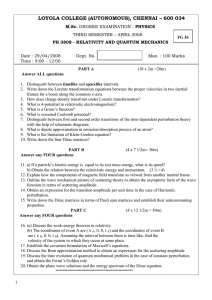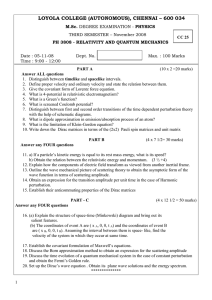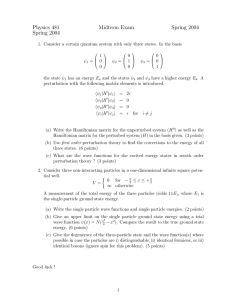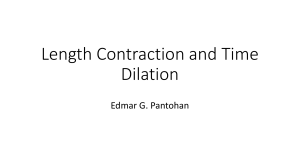LOYOLA COLLEGE (AUTONOMOUS), CHENNAI – 600 034
advertisement
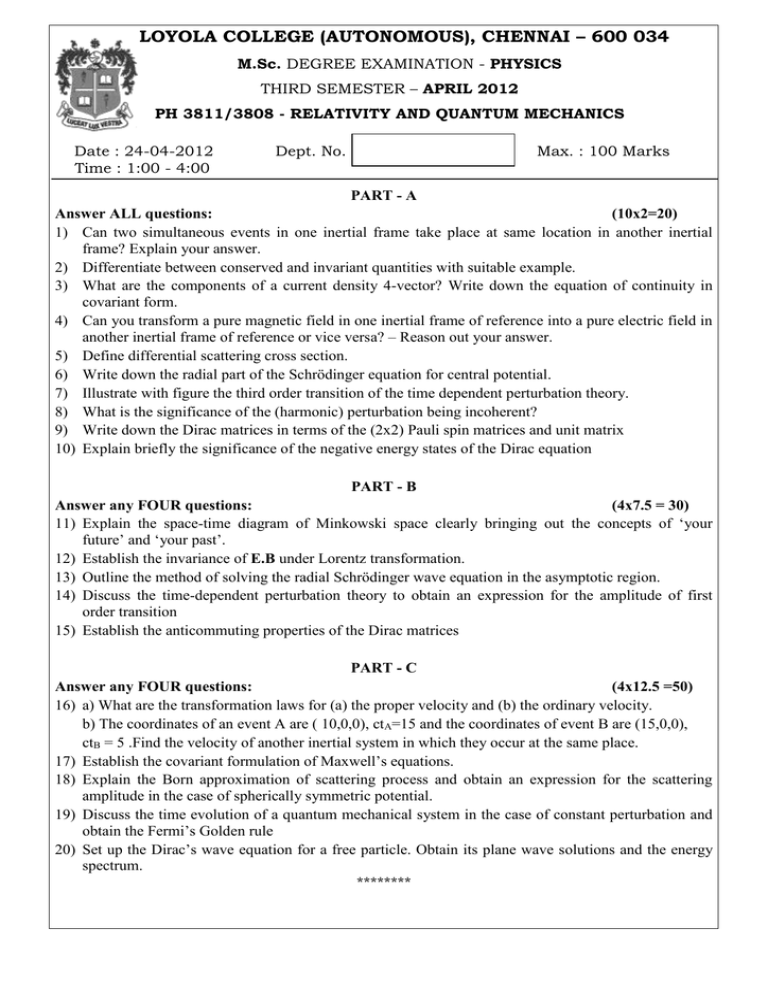
LOYOLA COLLEGE (AUTONOMOUS), CHENNAI – 600 034 M.Sc. DEGREE EXAMINATION - PHYSICS THIRD SEMESTER – APRIL 2012 PH 3811/3808 - RELATIVITY AND QUANTUM MECHANICS Date : 24-04-2012 Time : 1:00 - 4:00 Dept. No. Max. : 100 Marks PART - A Answer ALL questions: (10x2=20) 1) Can two simultaneous events in one inertial frame take place at same location in another inertial frame? Explain your answer. 2) Differentiate between conserved and invariant quantities with suitable example. 3) What are the components of a current density 4-vector? Write down the equation of continuity in covariant form. 4) Can you transform a pure magnetic field in one inertial frame of reference into a pure electric field in another inertial frame of reference or vice versa? – Reason out your answer. 5) Define differential scattering cross section. 6) Write down the radial part of the Schrödinger equation for central potential. 7) Illustrate with figure the third order transition of the time dependent perturbation theory. 8) What is the significance of the (harmonic) perturbation being incoherent? 9) Write down the Dirac matrices in terms of the (2x2) Pauli spin matrices and unit matrix 10) Explain briefly the significance of the negative energy states of the Dirac equation PART - B Answer any FOUR questions: (4x7.5 = 30) 11) Explain the space-time diagram of Minkowski space clearly bringing out the concepts of ‘your future’ and ‘your past’. 12) Establish the invariance of E.B under Lorentz transformation. 13) Outline the method of solving the radial Schrödinger wave equation in the asymptotic region. 14) Discuss the time-dependent perturbation theory to obtain an expression for the amplitude of first order transition 15) Establish the anticommuting properties of the Dirac matrices PART - C Answer any FOUR questions: (4x12.5 =50) 16) a) What are the transformation laws for (a) the proper velocity and (b) the ordinary velocity. b) The coordinates of an event A are ( 10,0,0), ctA=15 and the coordinates of event B are (15,0,0), ctB = 5 .Find the velocity of another inertial system in which they occur at the same place. 17) Establish the covariant formulation of Maxwell’s equations. 18) Explain the Born approximation of scattering process and obtain an expression for the scattering amplitude in the case of spherically symmetric potential. 19) Discuss the time evolution of a quantum mechanical system in the case of constant perturbation and obtain the Fermi’s Golden rule 20) Set up the Dirac’s wave equation for a free particle. Obtain its plane wave solutions and the energy spectrum. ********
